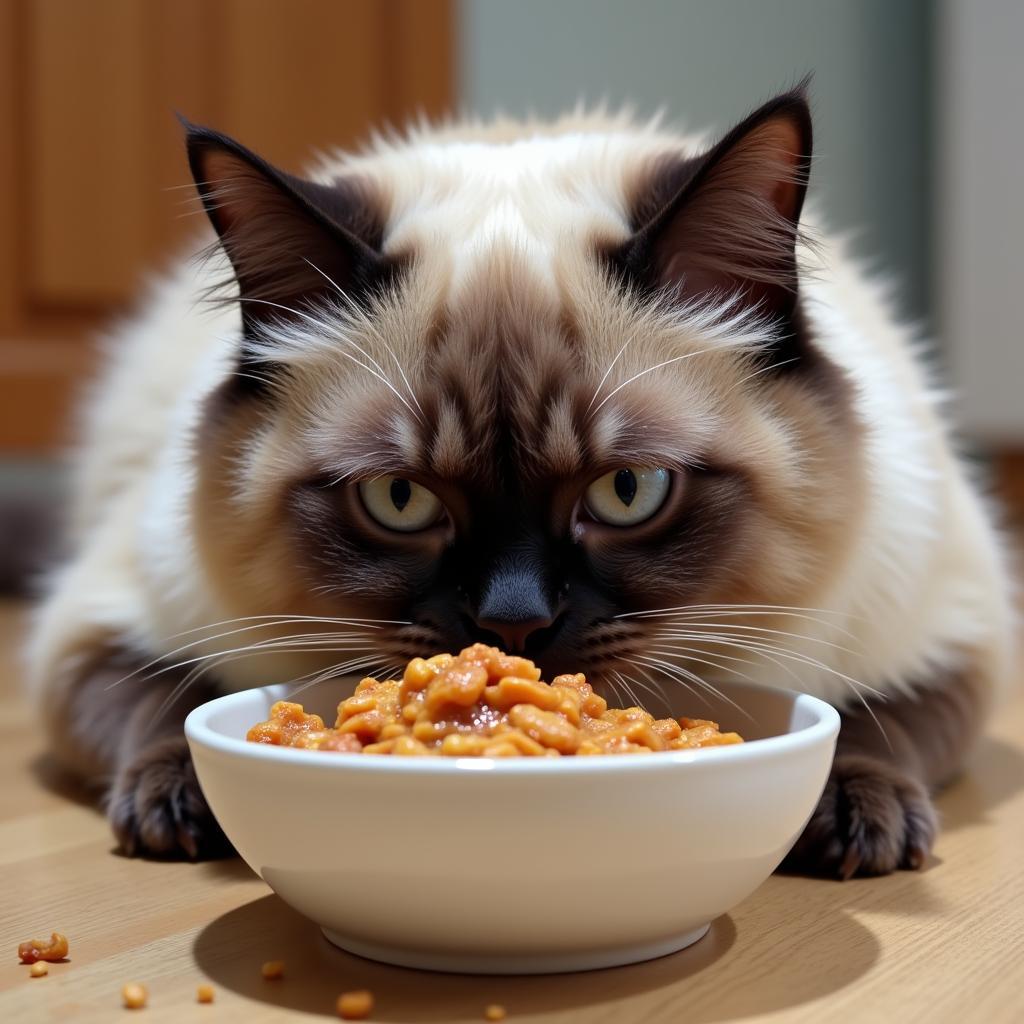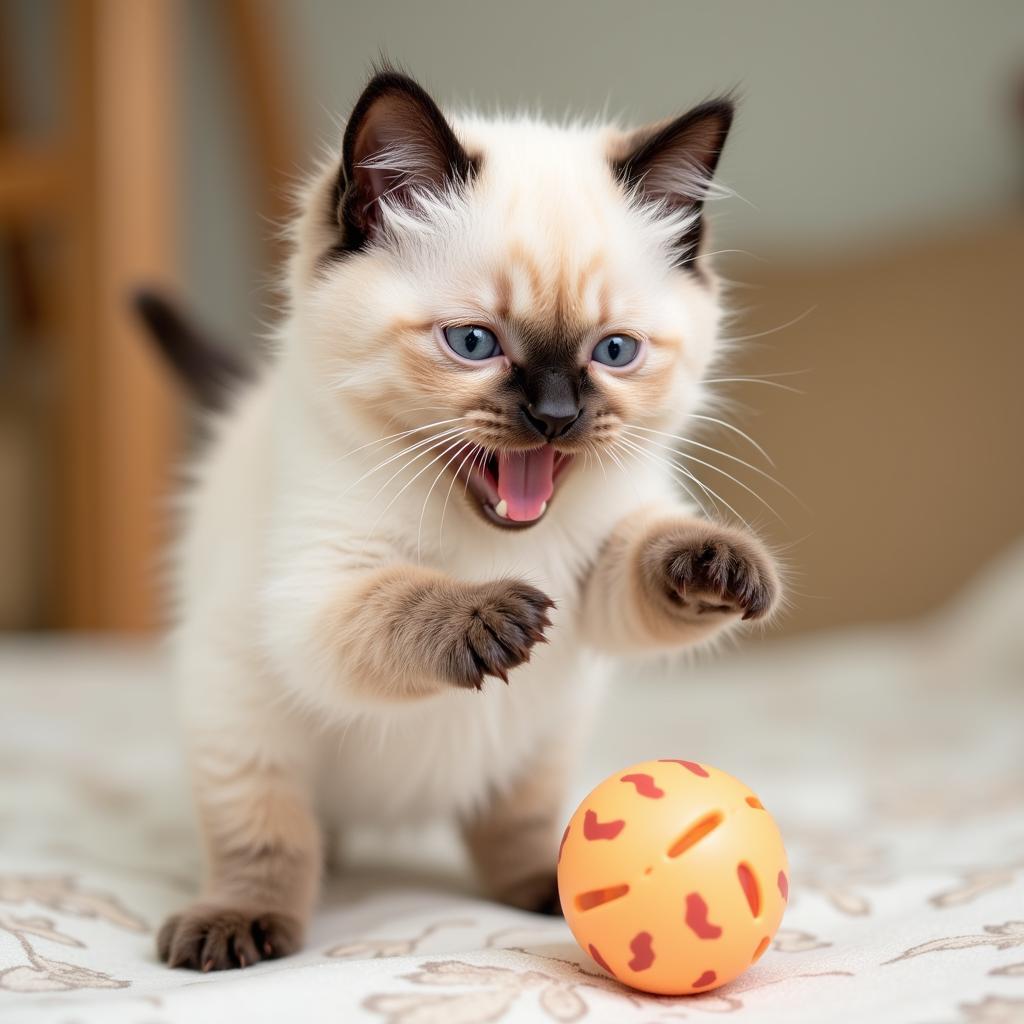Finding the best cat food for your Himalayan cat can feel like navigating a jungle of brands and ingredients. But ensuring your fluffy companion receives the optimal nutrition is crucial for their health and happiness. This guide will help you understand the specific dietary needs of Himalayan cats and make informed choices about their food.
Understanding the Himalayan Cat’s Dietary Needs
Himalayan cats, with their luxurious coats and captivating blue eyes, are a breed prone to certain health issues, including polycystic kidney disease (PKD) and urinary tract problems. Choosing the right food can play a significant role in mitigating these risks. Their long fur requires specific nutrients for maintenance, and their relatively inactive lifestyle means they can be prone to weight gain if their diet isn’t carefully managed. Therefore, a balanced diet with controlled calories and high-quality protein is essential.
What does a balanced diet look like? It should include a good balance of proteins, fats, carbohydrates, vitamins, and minerals. High-quality animal protein should be the primary ingredient, providing the essential amino acids your Himalayan needs for muscle development and overall health. Fats provide energy and support healthy skin and coat, while carbohydrates offer a secondary energy source.
Choosing the Right Type of Cat Food: Dry, Wet, or Raw?
Deciding between dry, wet, or raw food can be tricky. Each type has its pros and cons. Dry food is generally more affordable and convenient, while wet food offers higher moisture content, which can be beneficial for Himalayans prone to urinary tract issues. Raw food diets are gaining popularity, but it’s crucial to ensure they are nutritionally complete and prepared safely to avoid bacterial contamination.
Which is the best for your Himalayan? It depends on their individual needs and preferences. Some cats thrive on dry food, while others prefer the texture and taste of wet food. If you’re considering a raw food diet, consult with your veterinarian to ensure it meets your cat’s specific nutritional requirements.
Key Ingredients to Look For
When examining cat food labels, focus on high-quality animal protein sources like chicken, turkey, or fish as the primary ingredients. Avoid fillers like corn, wheat, and soy, which offer little nutritional value. Look for foods rich in omega-3 and omega-6 fatty acids for a healthy coat and skin. Taurine, an essential amino acid, is crucial for heart health and vision and should be included in your Himalayan’s diet.
Don’t be swayed by marketing jargon. Terms like “natural” and “gourmet” don’t necessarily indicate higher quality. Instead, focus on the ingredient list and the guaranteed analysis to assess the nutritional content. Consider your cat’s age and activity level when choosing a food. Kittens and active adults require higher calorie and protein content than senior cats.
What about Special Dietary Needs?
Some Himalayan cats may have specific dietary needs due to allergies or health conditions. If your cat has food allergies, look for hypoallergenic formulas that contain limited ingredients or novel protein sources like duck or venison. For Himalayans with sensitive stomachs, easily digestible formulas can help prevent digestive upset.
 Senior Himalayan cat enjoying wet food
Senior Himalayan cat enjoying wet food
Always consult with your veterinarian before making significant changes to your cat’s diet, especially if they have pre-existing health conditions. They can help you determine the best food to meet your Himalayan’s individual needs and ensure they are getting the proper nutrition for optimal health.
How to Transition Your Himalayan to a New Food
Switching your Himalayan to a new food should be done gradually to avoid digestive upset. Start by mixing a small amount of the new food with their current food and gradually increase the proportion of the new food over several days. Monitor your cat for any signs of digestive issues, such as vomiting or diarrhea, and adjust the transition pace accordingly.
“A slow and steady approach is key when transitioning your cat to a new food,” says Dr. Emily Carter, DVM, a feline nutrition specialist. “This allows their digestive system to adapt to the new ingredients and minimizes the risk of upset stomachs.”
Best Cat Food for Himalayan Kittens
Kittens require a diet rich in protein and calories to support their rapid growth and development. Look for kitten formulas specifically designed to meet their nutritional needs. These formulas typically have higher protein and fat content than adult cat food.
“Kittens have very different nutritional needs than adult cats,” advises Dr. Carter. “A kitten-specific formula ensures they get the right balance of nutrients for healthy development.”
 Playful Himalayan kitten
Playful Himalayan kitten
Conclusion
Choosing the best cat food for your Himalayan cat involves understanding their specific needs and selecting a high-quality food that meets those needs. By prioritizing a balanced diet with high-quality protein, avoiding fillers, and considering your cat’s individual health requirements, you can help your Himalayan companion live a long, healthy, and happy life. Remember to consult with your veterinarian for personalized dietary recommendations.
FAQ
- What is the best type of food for a Himalayan cat? The best type depends on your cat’s individual needs, but a high-quality diet with animal protein as the primary ingredient is essential.
- Should I feed my Himalayan cat dry or wet food? Both dry and wet food can be part of a healthy diet. Wet food provides more hydration, while dry food is more convenient.
- What are some common food allergies in Himalayan cats? Common allergens include beef, dairy, and fish.
- How much should I feed my Himalayan cat? Follow the feeding guidelines on the cat food label and adjust based on your cat’s age, activity level, and weight.
- What are the signs of a food allergy in a Himalayan cat? Signs can include itching, skin irritation, vomiting, and diarrhea.
- Can I feed my Himalayan cat a raw food diet? Consult with your veterinarian before starting a raw food diet to ensure it is nutritionally complete and safe.
- How often should I feed my Himalayan cat? Most adult cats do well with two meals a day.
For further information, explore our articles on cat nutrition and breed-specific health concerns. Need personalized advice? Contact us! Phone: 02437655121, Email: minacones@gmail.com or visit us at 3PGH+8R9, ĐT70A, thôn Trung, Bắc Từ Liêm, Hà Nội, Việt Nam. We have a 24/7 customer service team.